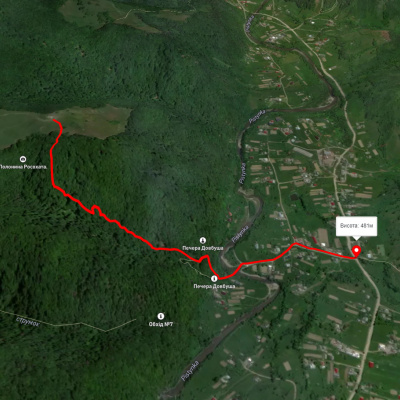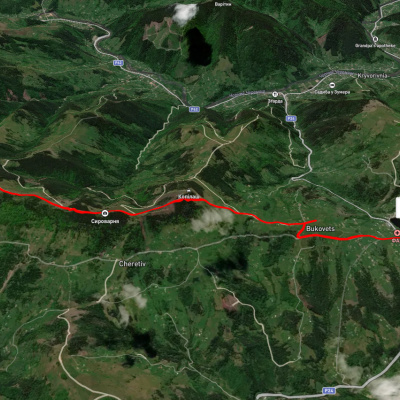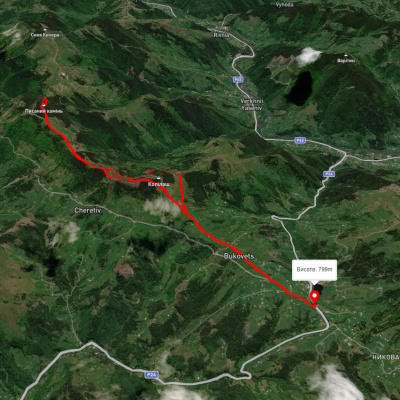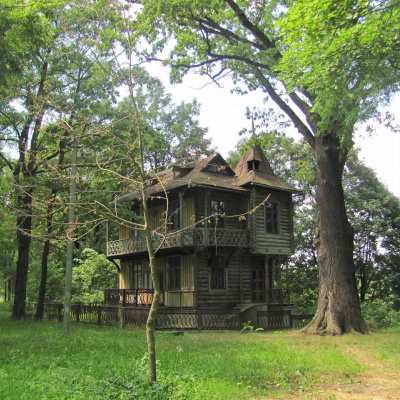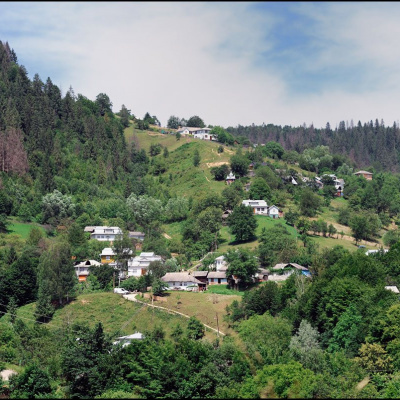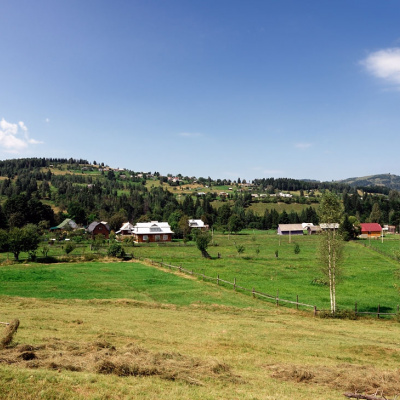Kosiv district
Kosiv district is an original and unique corner of the Hutsul region. The originality of the region is the beauty of its natural landscapes, a unique treasure trove of natural ecosystems, and rich flora and fauna. Kosiv district is a territory with a wide, diversified tourist infrastructure and is one of the most promising tourist and recreational areas of the Carpathian region. Kosiv district was formed in 1940. The district is located in the foothills and lowlands of the Pokuttya Carpathians. It borders with Sniatyn, Kolomyia, Nadvirna, and Verkhovyna districts of Ivano-Frankivsk region and Vyzhnytsia and Putyla districts of Chernivtsi region.
There are many natural monuments in a small area, which, in combination with historical, architectural and cultural monuments, are a good base for tourists. If you have never been to Kosiv region, be sure to find an opportunity to visit this wonderful land, where you will hear the sound of centuries and can gain strength and faith in the future.
The district consists of one city, two urban-type settlements and 37 village councils, with a total of 45 settlements. 60% of the district's settlements have the status of mountainous. The district center is the city of Kosiv, and the main tourist locations (settlements) of the district are: Sheshory, Kosmach, Yavoriv, Rika, Pistyn, Mykytyntsi, Stari Kuty, and Liucha.
Kosiv district is one of the most picturesque corners of the Hutsul region, a land of fertile fields, meadows and hayfields, high mountains, swift streams, clean healing air, and the widespread availability of clean water (drinking), including mineral water springs. The originality of this region, the beauty of its natural landscapes, rich flora and fauna, a unique treasure trove of natural ecosystems, where rare, relict species of flora and fauna have been preserved like nowhere else in Ukraine, folk customs, traditional household culture, folk crafts and inexhaustible riches of folklore have always attracted and continue to attract numerous tourists not only from Ukraine but also from many countries of the world. The habitability of the entire territory makes it extremely attractive for traveling for people of all ages and at any time of the year.
Kosiv district, as one of the mountainous districts of the region, has a small area of agricultural land - 39.6 thousand hectares or 44.0% of its total territory, of which about 30.0% is arable land, 63.3% is pastures and hayfields, and 7.8% is perennial plantations. Agricultural production is mainly carried out in individual households and 21 farms.
There are 7 recreation centers and private boarding houses, 4 sanatoriums, 1 children's recreation center, 4 hotels, 52 green tourism estates in the district.
Transport services for the population of Kosiv district are provided by 28 intra-district bus routes, which operate 98 daily return trips. In addition, there are 12 inter-district and 9 inter-regional bus routes that provide transportation to the regional center, as well as to neighboring districts and regions; there is a direct connection to the capital of Ukraine (Kosiv - Kyiv route). All rural settlements of the district are provided with regular bus service.
In Kosiv district there are 49 houses of culture, 50 libraries, 5 children's art schools (Kosiv, Kuty, Rozhniv, Yabluniv, Kosmach), 3 museums (Kosiv, Khimchyn, Kuty). There are 32 groups that have the honorary title of "People's" and 1 children's "Exemplary".
Kosiv is a town of rayon subordination located on the banks of the Rybnytsia River, known in Ukraine as the center of the Hutsul region. Archaeological finds, including stone axes and bronze items, indicate that the territory of the modern city was inhabited in the Neolithic and Copper Age. The first written information about Kosiv is found in a charter of the Lithuanian prince Svydryhailo from 1424. At first this place was called Rykiv, then Kosiv.
The ancient settlements include the villages of Kobaki (the village is mentioned in written sources in the early XV century under the name Zdvyzhen), Kuty (1448), and Vyzhnii Bereziv (1412). The peasants of Kosiv district took an active part in the Oprishkiv movement of the XVII-XVIII centuries. Oleksa Dovbush's detachment operated in the village of Kosmach. The famous leader tragically died here in 1745.
In the 1920s and 1930s, Kosiv became a center of Hutsul applied art. The artistic traditions of the masters of Yavoriv, Rika, and Brustorov were further developed in the works of Kosiv carvers. The works of the Kosiv carver and mosaicist V. Devdiuk were exhibited at exhibitions in Lviv, Krakow, and Vienna, where they received awards. Devdiuk's workshop produced many talented carvers, including: V. Kabyn, P. Baraniuk, M. Tymkiv, and Devdiuk's son Mykola.
People known outside of Ukraine were born, lived, and worked here, including Ukrainian writers and public figures M. Pavlyk, H. Pavlyk, M. Cheremshyna (I. Semeniuk), M. Koltsuniak, D. Pavlychko, M. Vlad, R. Ivanychuk, and others. Vlad, R. Ivanychuk, M. Yanovskyi, A. Krasovskyi (Andrii Hrim); carvers V. Havrysh, Y. Shkribliak, V. Shkribliak, M. Shkribliak, S. Korpaniuk, I. Korpaniuk, ceramics masters P. Tsvilyk, I. Verbivska, M. Rashchybuk.
Weaving, in particular, bedspread and carpet weaving, became a mass profession here. Blankets made by Yavoriv craftsmen were exhibited at the World's Fair in Montreal in 1967. Today this region is known as a center of tourism and folk crafts in Prykarpattia.
The originality of the region, the beauty of its natural landscapes, rich flora and fauna, a unique treasure trove of natural ecosystems with rare relict species of flora and fauna, and folk customs and traditional household culture like nowhere else in Ukraine attract numerous tourists of all ages. Kosiv district is famous for its rich natural landscapes and diverse flora and fauna, clean mountain air and mild climate, organic products, mineral water springs, waterfalls, and clear mountain rivers. The colorful Hutsul clothes, customs and rituals that date back to ancient times leave an indelible impression on anyone who has ever visited Kosiv region.
There are many tourist and recreational facilities on the territory of the district (51 hectares), where more than 1200 people can improve their health and relax at the same time.
Today, tourists can enjoy:
- 3 ski resorts;
- 17 museums;
- 37 natural monuments;
- 3 arboretums;
- 133 historical, cultural and architectural monuments;
- 3 horse riding centers;
- 30 tourist and excursion routes;
- Bicycle routes of varying difficulty;
- an airfield where, under the guidance of a five-time world aerobatics champion, tourists can take to the skies in a Yak-52 sports plane and explore the magnificent landscapes of the Carpathian region.
In addition, everyone has the opportunity to
- master the basics of a beginner climber;
- travel on horseback on thoroughbred sport horses;
- meet folk craftsmen in workshops on Easter eggs, pottery, carving, weaving and embroidery;
- see permanent exhibitions of works by artists and folk craftsmen of the Hutsul region in the exhibition halls of the regional organization of the National Union of Artists of Ukraine;
- enjoy rafting on the stormy waters of the Cheremosh;
- swim in mountain rivers with many small waterfalls;
- see unique species of medicinal plants;
- climb the highest peak in Kosiv region - Mount Gregit;
- skiing in the winter to your heart's content;
- Hear the sounds of trembita and meet masters who make cymbals, violins, flutes, drymbas, and trembitas with their own hands;
- Listen to the melodies of the charming Hutsul troyist musicians;
- taste the favorite dishes of the highlanders - nutritious, environmentally friendly and very healthy, in particular: banush, goulash, brynza, vurda, mushrooms, dumplings with blueberries (athens), etc;
- visit the Kosiv (Smodnia) Fair and buy authentic handicrafts made of wood, metal, ceramics, beads, wool, etc;
- visit the arboretum of the Kosiv sanatorium;
- visit historical, cultural, and architectural monuments, and the estate-museum of Patriarch Volodymyr (Romaniuk) of the Ukrainian Orthodox Church-Kyivan Patriarchate.
Rural green tourism is becoming increasingly popular in the area. Today, more than 50 rural owners are ready to receive guests in their estates. Genuine joy and the opportunity to find yourself in the arms of nature await you here at every step! The people who live here, as is customary in the mountains among the Hutsuls, are always happy to have guests in their homes. Maybe that's why Hutsul vodka is so intoxicating and the dishes are so delicious.
Mountain Search and Rescue Service, 15a Nad Hukom St., +38 (03478) 2-16-77.
Architectural monuments
- Ascension Church (1896), wooden with a stone bell tower, Babyn village
- Church of the Ascension (1795), wooden with a bell tower, Brusturiv village
- St. Stephen's Church (1866), wooden with a bell tower, Horod village
- Annunciation Church (1850), wooden with a bell tower, Verbovets village
- St. Dmytro's Church (1895), wooden with a bell tower, Velykyi Rozhyn village
- Transfiguration Church (1851), wooden with a stone bell tower, Rozhniv village
- Church of the Virgin Mary (1867), wooden with a bell tower, Rozhniv village
- St. Basil's Church (1896), wooden with a stone bell tower, Rika village
- Peter and Paul Church (1904-1905), wooden with a bell tower, Kosmach village
- Church of the Ascension (1844), wooden with a bell tower, Liucha village
- St. Michael's Church (early nineteenth century), wooden, Liuchky village
- Church of the Nativity of John the Baptist (1860), wooden with a bell tower, Malyi Rozhyn village
- Church of the Cathedral of the Virgin Mary (1889), wooden with a bell tower, Prokurava village
- Zdvyzhenska church (1950), wooden with a bell tower, Mykytyntsi village
- St. Barbara (Assumption) Church (1858), wooden with a stone bell tower, Pistyn village
- Church of the Descent of the Holy Spirit (1866), wooden with a stone bell tower, Sokolivka village
- Church of St. James and St. Anna (1841), wooden with a bell tower (1773), Smodna village
- Peter and Paul Church (nineteenth century), wooden with a bell tower, Snidavka village
- Church of the Savior (1868), wooden with a bell tower (1881), Stari Kuty village
- St. John's Church (1842), wooden with a stone bell tower (1850), Cherhanivka village
- St. Paraskeva Church (1874), wooden with a bell tower, Sheshory village
- Church of the Nativity of the Virgin Mary (1926), wooden with a bell tower, Yavoriv village
- City Jewish cemetery, Kosiv
Natural monuments
- Hutsulshchyna National Nature Park. It is intended for the conservation, reproduction and rational use of genetic resources of flora and fauna, unique natural complexes and ethno-cultural environment of the Pokuttya-Bukovyna Carpathians. It is located in the most interesting region of Ukraine, where the ancient original crafts, trades, traditions, and customs of the Hutsul ethnic group are most clearly preserved. There are ecological educational trails here, and equestrian tourism, rural green tourism, and ethnotourism are intensively developing. The highest peak of the park is Mount Gregit (1472 m), whose slopes are covered with stone placers and are locally called "gregety." Some ridges, such as Sokilskyi, have cliffs 20-40 meters high, which are used as training grounds for mountain tourists and climbers.
- The Sokilskyi cliff is a steep wall 100 meters high near the village of Velykyi Rozhyn. The Cheremosh flows here at high speed, washing away the rock fragments. The Sykavka stream flows into it, forming 2 waterfalls, one of which is a monument to Taras Shevchenko. Despite the waterfall, there is a 15 km long climb to the Sokilskyi ridge. On the ridge, shallow saddles alternate with peaks, mixed forests give way to sprawling meadows. Spruce and beech forests are the most common, followed by birch and sycamore groves. The greatest value on the Sokilskyi Ridge is more than 20 sandstone cliffs over 40 meters high.
- City Mountain (450 m), Kosiv, which offers a panoramic view of the city and neighboring villages, a view of the Pokutsko-Bukovyna Carpathians. The mountain is home to black alpine pines, unique to the Carpathian region, as well as deciduous and coniferous plantations, and white acacia thickets.
- Mount Tarnoshora (998 m). The name comes from the word "tarnitsa" (horse saddle), giant rocks, up to 30 m high with many labyrinths, corridors, and gorges, go down from the top; there are several caves.
Protected tracts
- Lebedyn, Sheshory village. A rare lake up to 11 m deep, located among forests and meadows at an altitude of 650 m.
- Hayivka, Kosmak Forestry. Plantations of white fir and spruce 100 years old.
- Khomynske is a 100-year-old beech plantation.
- Dilok - a 50-year-old red oak plantation.
- Utoropy - a valuable forest plantation of scots pine with an admixture of spruce and fir aged 105 years.
- Arboretum of the Kosiv sanatorium, Smodna village. A unique collection of trees and shrubs (729 specimens of 44 plant species) collected from all over the world by scientist A. Tarnavsky in the last century.
- Arboretum "Dendrarium", Yablunivka forestry. The collection of plants includes about 70 species of introduced trees.
Waterfalls
- Silver waterfalls (3 m, 5 m), Sheshory village
- Huk (2.5 m), Kosiv.
- Luzhkivskyi (14 m), Velykyi Rozhyn village, located about 6 km from the Chernivtsi-Verkhovyna highway, at the beginning of Luzhkyi village
- Rushyrskyi waterfall (4 m), Yabluniv village, Lyucha village
- Yavorivskyi huk (6 m), Yavoriv village, turn to Shyrokyi village
- Shepitsky Big and Small Hook (15 m and 2 m), Shepit village
Mineral springs
- With high content of organic substances, Sheshory village
- Hydrogen sulfide spring, Prokurava village, Petrychyla tract
- Pistyn salt well, Pistyn village
- Hydrogen sulfide spring, Kosiv city
- Utoropi salt springs, Utoropy village
- м. Kosiv - tourist complex "Carpathian Dawns" - Dovbush's stone, distance 5.5 km, altitude 200 m;
- м. Kosiv - Babyn village - Khr. Sokilskyi - Tyudiv village, distance 15 km, altitude difference 453 m;
- м. Kosiv, tourist complex "Carpathian Dawns" - the village of Horod - water mill, distance 5.5 km, height difference 30 m;
- м. Kosiv, tourist complex "Carpathian Dawns" - hydrogen sulfide spring - g. Stizhky, distance 4.2 km, height difference 271 m;
- м. Kosiv - m. Mykhalkiv, distance 4.8 km, altitude difference 392 m;
- м. Kosiv - Dovbush stone - Khr. Kamystychnyi, distance 6 km, height difference 250 m;
- Kuty - Sokilski rocks - Tyudiv village, distance 19 km, height difference 520 m;
- с. Pistyn - Church of the Assumption of the Blessed Virgin Mary - Sheshory village - Sheshory waterfalls, distance 12 km, height difference 150 m;
- с. Pistyn - the Church of the Assumption of the Blessed Virgin Mary - g. Klyva, distance 2.7 km, height difference 226 m;
- с. Sheshory - m. Velykyi Pohar - Mt. Rokyta, distance 3.5 km, altitude difference 370 m;
- с. Sheshory - Lake Lebedyn - Lake Mertve - Dovbush Caves - Sheshory village, distance 18 km, altitude difference 410 m;
- с. Liucha - Fedytselya meadow - Mt. Piskova - Mt. Kamen - valley of the Rushorets River - Lake Lebedyn, distance 8 km, height difference 210 m;
- с. Shepit - Mt. Grehit - Shepitski Huki waterfall - Shepit village, distance 16 km, altitude difference 852 m;
- с. Yavoriv (Bezulka village) - v. Snidavka - Mt. Ternoshora - Yavoriv village, route length 12 km, altitude difference 330 m;
- с. Yavoriv - Zholob tract - Sokilskyi Khr. Sokilskyi, distance 3 km, altitude difference 439 m;
- Bukovetsky pass - Mt. Kopylash - Mt. Pysanyi Kamen, distance 6 km, altitude difference 411 m.
Які туристичні (пішохідні) маршрути проходять через/біля Kosiv district?
Пропонуємо пройти такі туристичні (пішохідні) маршрути через/біля Kosiv district: Шешори - Росохата, Писаний Камінь – с. Буковець, с. Буковець – Писаний Камінь – с. Буковець, с. Космач, через г. Ротило, г. Грегіт, г. Біла Кобила до с.Буковець, На Довбушеві Комори, пер. Німчич - Протяте Каміння
